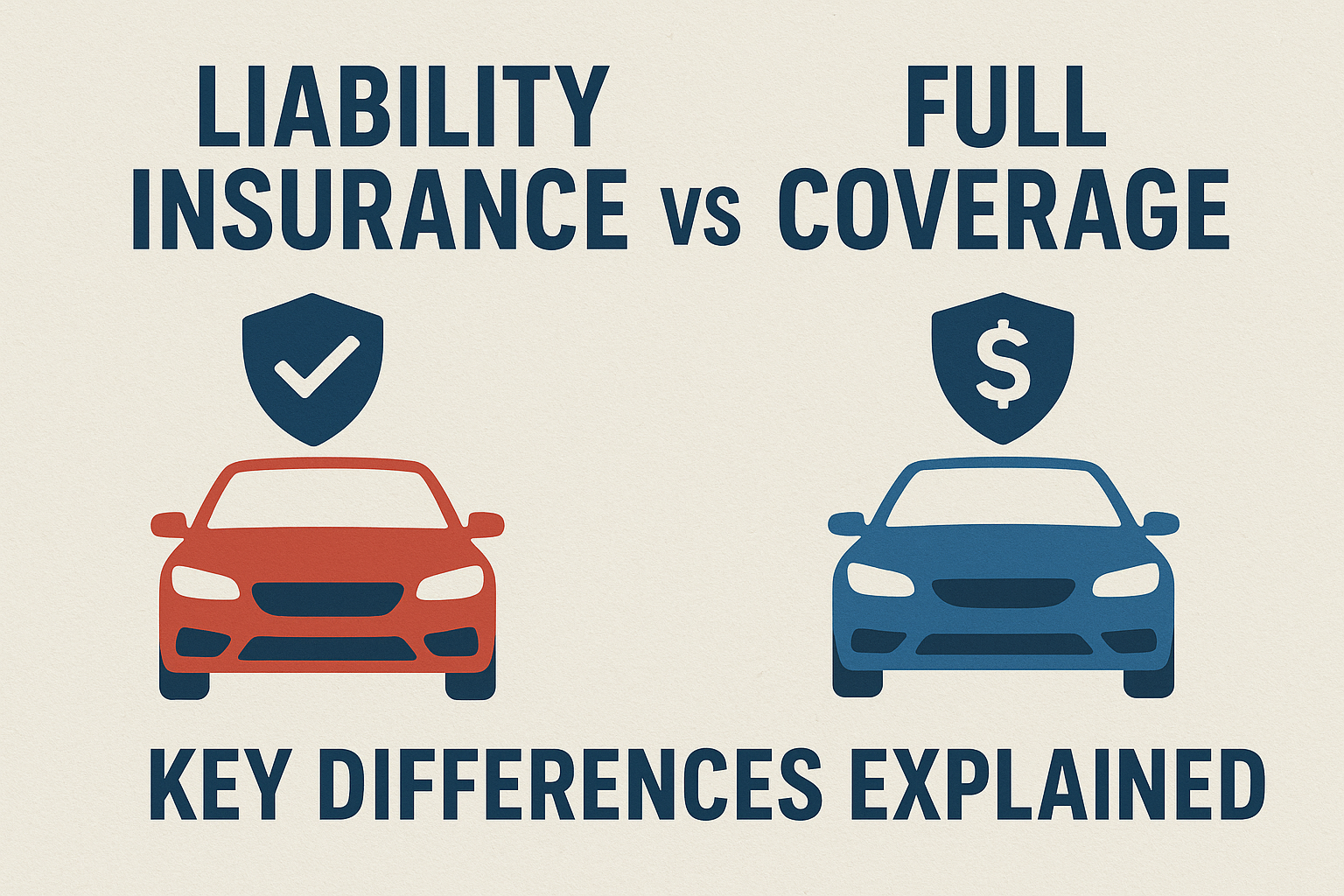When shopping for auto insurance, one of the most common questions drivers face is: Should I go with liability insurance or full coverage? The answer isn’t one-size-fits-all—it depends on your budget, the value of your car, and your personal financial situation.
Both liability insurance and full coverage auto insurance play important roles in protecting you on the road. However, they cover very different things. Liability insurance is the minimum coverage required by law in most states, while full coverage combines liability with additional protections for your car.
This blog will break down liability insurance vs full coverage, highlight their key differences, and help you decide which is best for your needs.
What Is Liability Insurance?
🚗Liability insurance covers the other driver’s expenses if you cause an accident. It does not cover your own vehicle or injuries.
There are two main parts of liability insurance:
- Bodily Injury Liability (BI): Pays for the other driver’s medical bills, lost wages, or legal costs.
- Property Damage Liability (PD): Pays for repairs to the other person’s vehicle or property.
👉 In short, liability insurance covers others, not you.
What Is Full Coverage Insurance?
🛡️Full coverage auto insurance isn’t a specific policy. Instead, it’s a combination of coverages that protect both you and others. Typically, full coverage includes:
- Liability Insurance (required by law)
- Collision Coverage – Pays for damage to your own car in an accident, regardless of fault.
- Comprehensive Coverage – Pays for damage not caused by collisions (theft, vandalism, fire, floods, hail, or hitting an animal).
Some policies may also include:
- Uninsured/Underinsured Motorist Coverage
- Medical Payments/Personal Injury Protection (PIP)
👉 In short, full coverage is liability + protection for your car.
Cost Comparison: Liability vs Full Coverage
- Liability Insurance Cost: On average, liability-only policies are 40–60% cheaper than full coverage.
- Full Coverage Cost: More expensive, but protects your investment in a vehicle.
👉 Example:
- Liability Insurance: $600 per year
- Full Coverage: $1,400 per year
While liability may save you money upfront, it leaves you exposed to high out-of-pocket costs if your own car is damaged.
Pros and Cons of Liability Insurance
✅ Pros
- Lowest cost option
- Meets legal requirements
- Ideal for older/low-value cars
❌ Cons
- Doesn’t cover your car
- You pay out-of-pocket for repairs
- Not suitable if your car is financed or leased
Pros and Cons of Full Coverage
✅ Pros
- Covers both your car and others
- Includes theft, fire, natural disasters
- Required by lenders for financed/leased vehicles
- Peace of mind
❌ Cons
- Higher premium costs
- May not be worth it for older cars
When Should You Choose Liability Insurance?
- Your car is old and not worth much.
- You want the cheapest legal option.
- You can afford out-of-pocket repairs or replacement.
Example: If your 15-year-old car is worth $2,000, paying $1,200 a year for full coverage may not make sense.
When Should You Choose Full Coverage?
- Your car is new, expensive, or financed.
- You live in an area with high theft or vandalism rates.
- You want complete financial protection.
- You can’t afford large repair bills.
Example: A new $35,000 car financed by a loan usually requires full coverage, as lenders want their investment protected.
Real-Life Scenarios
- Scenario 1: Young Driver on a Budget
An 18-year-old with a 12-year-old car may choose liability-only to keep insurance costs low. - Scenario 2: Family with New SUV
A family financing a $40,000 SUV opts for full coverage to protect against both accidents and theft. - Scenario 3: Retiree with Paid-Off Vehicle
A retiree with a low-value car might drop to liability insurance to save money.
Legal Requirements in the U.S.
Most U.S. states require liability insurance as a minimum, but not full coverage. However, if you finance or lease a car, the lender typically requires full coverage until the loan is paid off.
Tax & Financial Perspective
- Liability Insurance: No tax benefits; purely legal and financial protection.
- Full Coverage: Not tax-deductible for personal use but may be deductible for business vehicles.
👉 For most drivers, insurance is about managing financial risk, not tax planning.
Expert Tips for Choosing the Right Policy
- Compare Quotes Online – Use multiple insurers to find the best rates.
- Assess Car Value – Don’t pay for full coverage if your car’s value is less than your annual premium.
- Consider Deductibles – Higher deductibles lower your premiums.
- Bundle Policies – Combine home and auto insurance to save money.
- Review Annually – As your car ages, consider switching from full coverage to liability.
Frequently Asked Questions (FAQs)
1. Is liability insurance enough?
Yes, if your car is old or low-value. But it won’t cover your own damages.
2. Is full coverage worth it?
Yes, if your car is new, valuable, or financed. It provides maximum protection.
3. Can I switch from full coverage to liability?
Yes, once your loan is paid off and your car’s value has depreciated.
4. Which is cheaper—liability or full coverage?
Liability is always cheaper, but it provides limited protection.
5. Does full coverage mean everything is covered?
No. It still excludes wear and tear, mechanical breakdowns, and routine maintenance.
Conclusion: Liability vs Full Coverage
The choice between liability insurance and full coverage comes down to your car’s value, financial situation, and risk tolerance.
- Choose Liability Insurance if you want the most affordable option and drive an older car.
- Choose Full Coverage if you want total protection, especially for newer or financed cars.
👉 Best Strategy: Start with full coverage for new cars and switch to liability-only as your car ages and depreciates. This ensures maximum protection without overpaying for insurance you don’t need.

